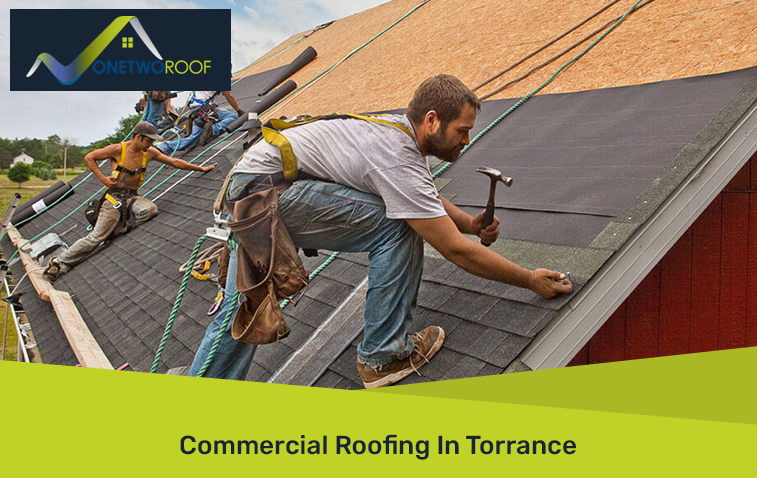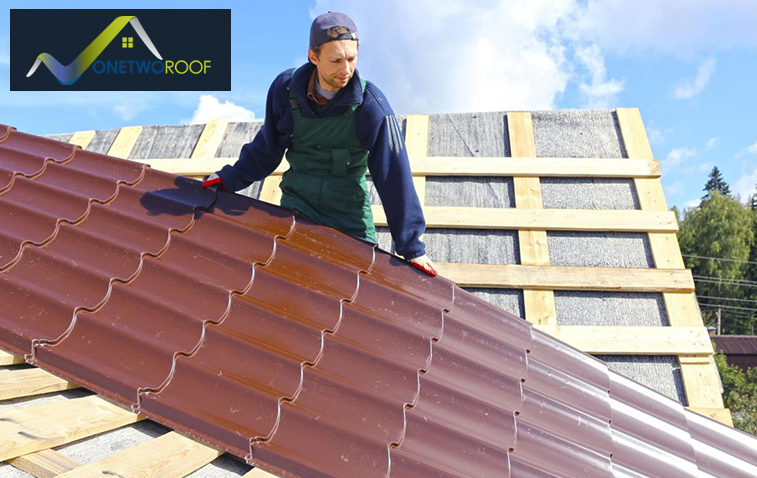Commercial Roofing in Torrance
One Two Roof offers specialized services for commercial roofing in Torrance. A commercial building roof is different from residential roofing in many ways. Commercial roofs are typically larger and more complex than residential roofs, and they may have unique features like drainage systems, skylights, or HVAC equipment that require specialized knowledge and expertise.

Apart from that, commercial roofs are subject to different codes and regulations than residential roofs. That’s why it’s essential to hire a professional roofing contractor for any commercial roofing project. We offer services such as roof inspections, repairs, replacements, and maintenance. One Two Roofing has the tools, equipment, and expertise to ensure that your commercial roof is installed or repaired correctly and in compliance with all applicable codes and regulations. Contact us today to get the perfect roofing solution.
Get Complete Commercial Roofing Solutions in Torrance
At One Two Roof, you get a range of services related to the installation, repair, and maintenance of roofs on commercial buildings. Here are some of the most common services that you get:
Installation
Get help in installing different types of roofs such as flat, metal, tile, and shingle roofs. Select the most suitable roofing material based on the building’s structure, location, and budget.
Repair
If a commercial roof is damaged due to weather, wear, and tear, or other factors, get the right services to repair the roof. We help with fixing leaks, replacing damaged shingles or tiles, patching holes, and more.
Maintenance
Regular maintenance is critical to extending the lifespan of a commercial roof. Get routine maintenance services such as cleaning gutters, checking for leaks, and repairing minor damages.
Replacement
When a commercial roof is beyond repair, it may need to be replaced. We help you determine when a roof replacement is necessary and provide installation services for the new roof.
Inspection
Regular roof inspections can help detect potential issues early and prevent costly repairs down the road. Commercial roofing contractors can perform thorough inspections of the roof, identify any problems, and provide recommendations for repair or replacement.
Emergency Roof Repair
In case of an emergency, such as a severe storm or natural disaster, commercial roofing contractors offer 24/7 emergency repair services to ensure the safety and protection of the building’s occupants and assets.
The Different Components of a Commercial Roof
| Component | Description |
|---|---|
| Roof Deck | The structural foundation of the roof, typically made of wood, concrete, or metal, provides support for the roofing materials. |
| Roof Insulation | The insulating material is installed to regulate temperature, prevent heat transfer, and enhance energy efficiency within the building. |
| Roof Membrane | The outermost layer of the roof system, is usually made of synthetic materials like EPDM, PVC, TPO, or modified bitumen. |
| Flashing | Metal or other materials used to prevent water penetration at intersections or transitions, such as roof edges, chimneys, or vents. |
| Roof Underlayment | A layer installed between the roof deck and the membrane to provide additional waterproofing and protection against moisture. |
| Roof Vents | Installed to promote air circulation and prevent the buildup of heat and moisture, ensuring proper ventilation in the building. |
| Roof Drainage System | A network of gutters, downspouts, and drains designed to channel water away from the roof to prevent pooling and water damage. |
| Roof Access Hatch | A secure, controlled access point that allows entry to the roof for maintenance, inspection, and repair purposes. |
| Skylights | Transparent or translucent windows installed on the roof to allow natural light into the building, enhancing energy efficiency. |
| Roof Edge Protection | Safety measures like guardrails, parapet walls, or safety anchors installed around the roof perimeter to prevent falls or accidents. |
| Roofing Fasteners | Nails, screws, or adhesive materials used to secure the roofing components to the roof deck and ensure structural integrity. |
Important Rules and Regulations for Roofing According to California
When you are looking for commercial roofing in Torrance, then you need to follow the California State Building Code.

Here are some important provisions related to roofing as mentioned in Chapters 8 &9, Title 24 of the California Building Code 2022
R801.3 Roof Drainage
In areas where expansive soils or collapsible soils are known to exist, all dwellings shall have a controlled method of water disposal from roofs that will collect and discharge roof drainage to the ground surface not less than 5 feet (1524 mm) from the foundation walls or to an approved drainage system.
R806.1 Ventilation Required
Enclosed attics and enclosed rafter spaces formed where ceilings are applied directly to the underside of roof rafters shall have cross ventilation for each separate space by ventilating openings protected against the entrance of rain or snow. Ventilation openings shall have a least dimension of 1/16 inch (1.6 mm) minimum and 1/4 inch (6.4 mm) maximum. Ventilation openings having a least dimension larger than 1/4 inch (6.4 mm) shall be provided with corrosion-resistant wire cloth screening, hardware cloth, perforated vinyl, or similar material with openings having a least dimension of 1/16 inch (1.6 mm) minimum and 1/4 inch (6.4 mm) maximum. Openings in roof framing members shall conform to the requirements of Section R802.7. Required ventilation openings shall open directly to the outside air and shall be protected to prevent the entry of birds, rodents, snakes, and other similar creatures
Section R904 Materials
R904.2 Compatibility of Materials
Roof assemblies shall be of materials that are compatible with each other and with the building or structure to which the materials are applied.
R904.4 Product Identification
Roof covering materials shall be delivered in packages bearing the manufacturer’s identifying marks and approved testing agency labels required. Bulk shipments of materials shall be accompanied by the same information issued in the form of a certificate or on a bill of lading by the manufacturer.
R905.1.1 Underlayment
Underlayment for asphalt shingles, clay and concrete tile, metal roof shingles, mineral-surfaced roll roofing, slate and slate-type shingles, wood shingles, wood shakes, metal roof panels and photovoltaic shingles shall conform to the applicable standards listed in this chapter. Underlayment materials required to comply with ASTM D226, D1970, D4869 and D6757 shall bear a label indicating compliance to the standard designation
